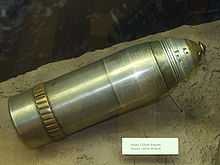Driving band

The driving band or rotating band is part of an artillery shell, a band of soft metal near the middle of the shell, typically made of gilding metal, copper or lead. When the shell is fired the pressure of the propellant swages the metal into the rifling of the barrel, providing a seal preventing the gases from blowing past the shell and engaging with the rifling to spin-stabilize the shell. In a small-arms rifle, the entire bullet is typically covered in copper or a similarly soft alloy, so the entire bullet is its own driving band.
One disadvantage of the use of a driving band is that it must be placed at the widest point on the shell, and also near the balance point; these points would ideally (for this purpose) coincide. At high supersonic speeds aerodynamic considerations require the widest point to be far to the rear of the balance point. Another issue is that with increasing shell weight it becomes more difficult to engineer the driving band. Instead of the propellant gases driving the shell up the barrel, they can simply blow the driving band off the shell.
Some weapons that operate at high rates of fire, such as the GAU-8 Avenger gatling cannon, use plastic driving bands rather than soft metal. The advantage in using plastic as a swage material in such cases is reduced wear on the barrel rifling, extending the life and average accuracy of the weapon.
Variations
Driving bands pre-cut for the rifling have been used for muzzle loaded weapons, e.g. some mortars. Freely rotating bands can be used to reduce the spin imparted to the round as is preferable for HEAT warheads or fin-stabilised projectiles fired from general-purpose rifled barrels.
Gerald Bull worked extensively on ways to eliminate the driving band, leading to the development of his Extended Range, Full Bore ammunition using an inversion of the pre-cut rifling for his GC-45 howitzer, which is now rapidly replacing older artillery worldwide.[citation needed]